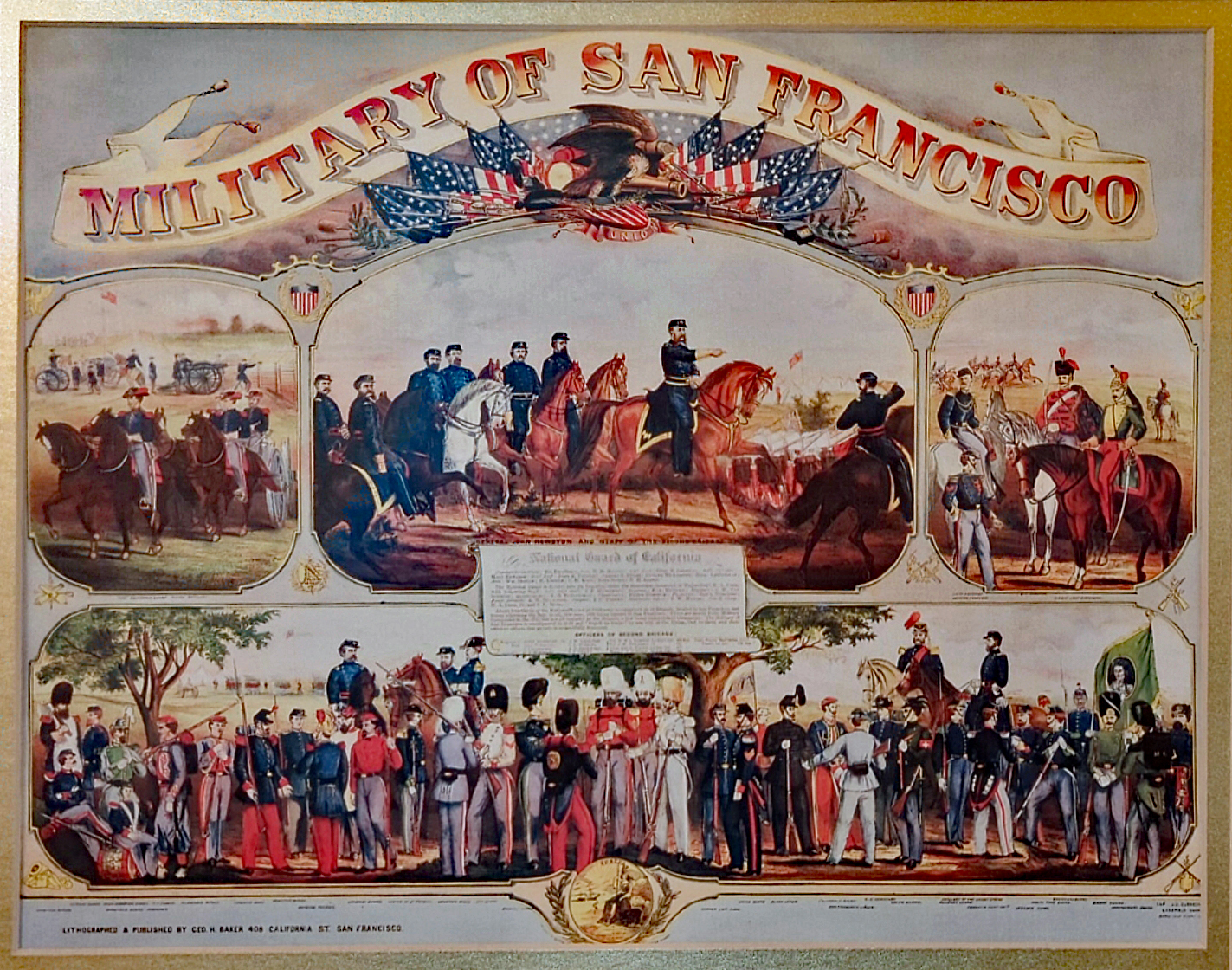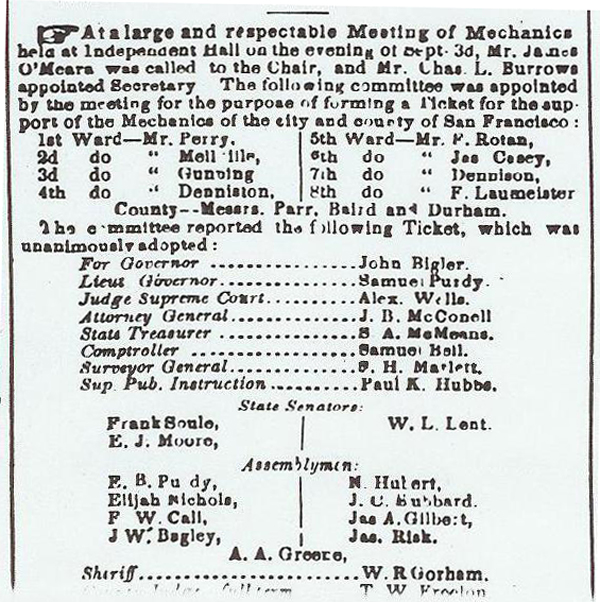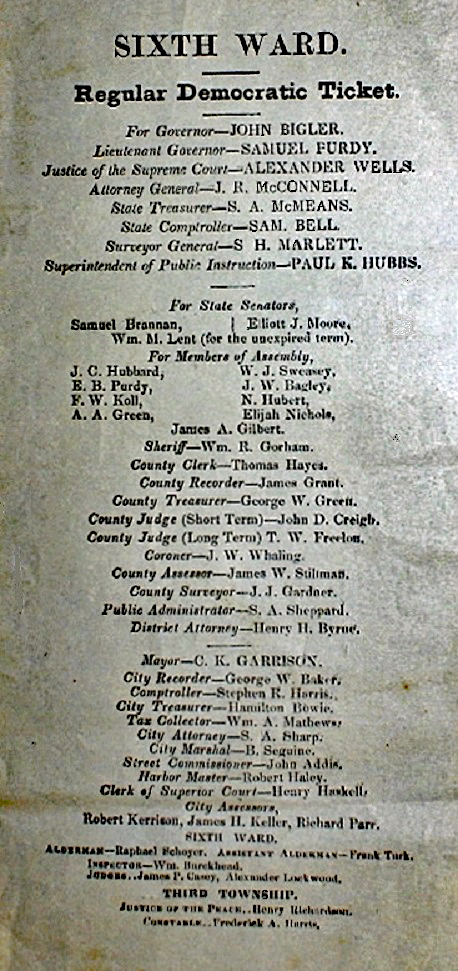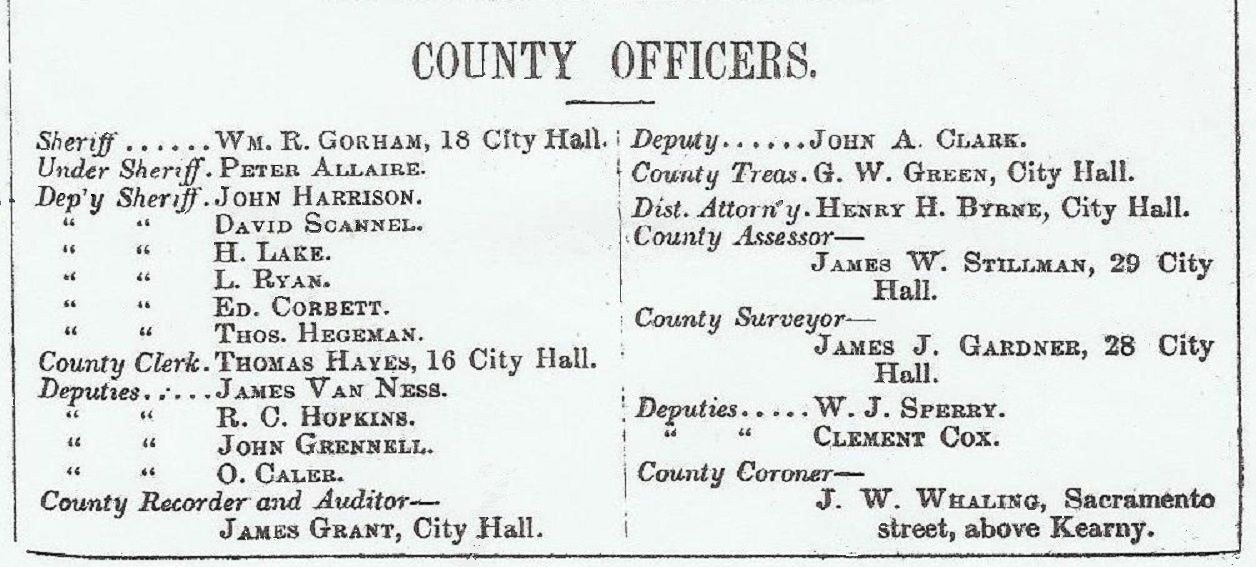A loud and unruly crowd of ten thousand people gathered at an open field near San Francisco’s Presidio late one Friday morning. It was execution day and Sheriff William Gorham was about to conduct the last legal public hanging in the City’s history. The year was 1854.
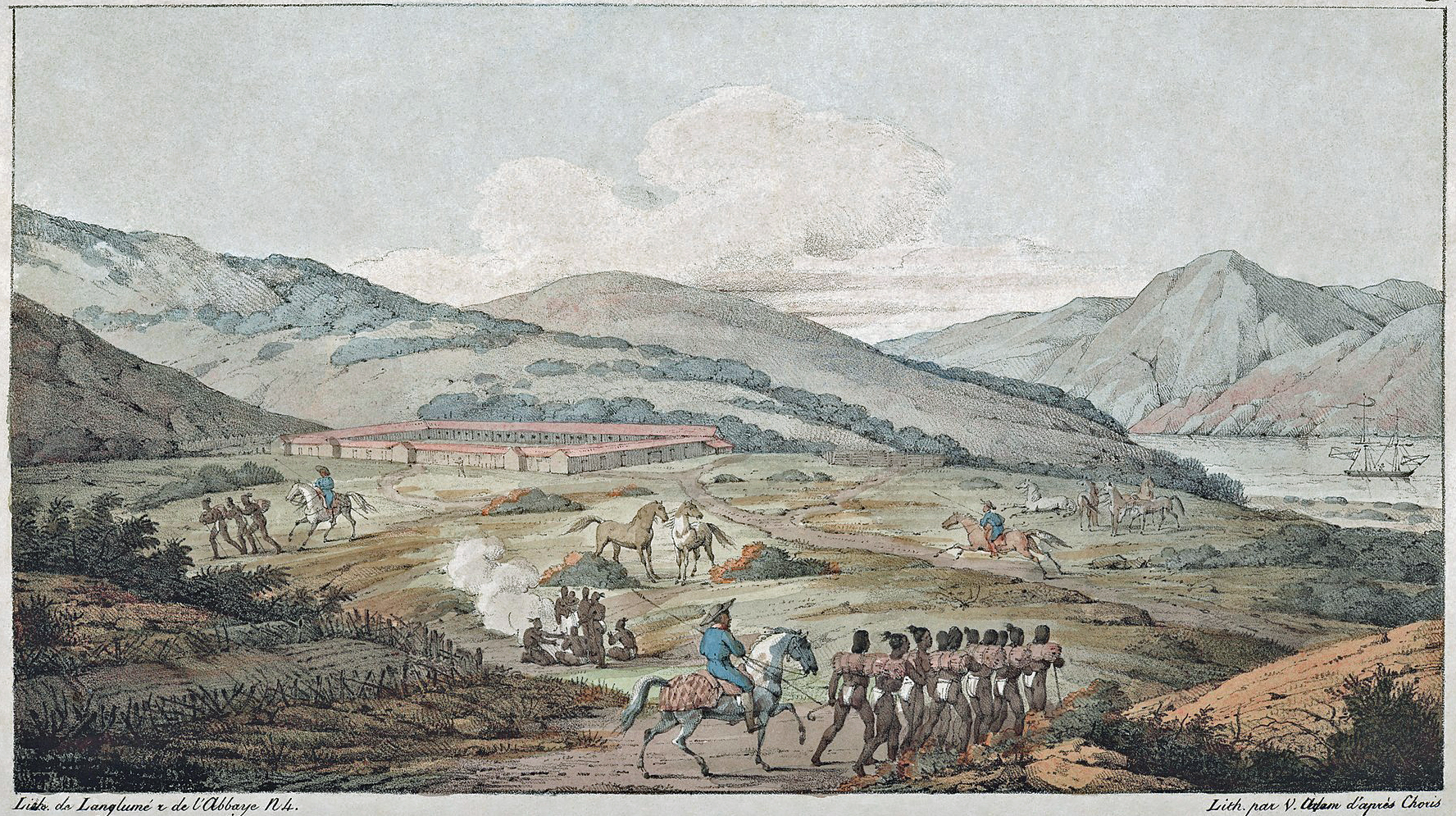
The San Francisco Presidio in 1822. In 1776 Spanish explorer Juan Bautista de Anza established a military post on a strip of Ohlone Indian land overlooking the entrance to San Francisco Bay. The Presidio was Spain's northern-most colonial outpost in the New World, and by 1783 the garrison consisted of 33 soldiers and several dozen civilians.
The Presidio was seized by the US Military in 1846, at the start of the Mexican-American War.
In 1996, just as the land was about to be auctioned off, The Presidio Land Trust was established by the Federal Government to permanently preserve and develop the 1,491 acres for public use.
William Sheppard was born in Ireland, who had lived in California for four years at the time he was charged with murder. He had been a seaman virtually all of his life and had become friends with a man named Henry Day. Mr. Day was attempting to establish a ranch and had invited Sheppard to live on the property and help with the ranch. Sheppard fell in love with Day’s young daughter and she with him. According to Sheppard’s statement, both Mr. and Mrs. Day were happy that the two might one day marry. But Mr. Day viewed the situation quite differently.
As is often the case, the circumstances of Henry Day’s murder depended upon whom you believed. The official version is that Mr. Day was stabbed three times by Sheppard because Day had forbidden Sheppard to marry his daughter. Day lived only about an hour after being stabbed but lived long enough to identify Sheppard as the murderer.
Sheppard consistently professed his innocence right up to the moment he was hanged. Sheppard stated that he and Day were taking a walk along the wharf when he was attacked from behind. He fell and saw the attacker then stab Mr. Day and then jump into the water. His explanation did not convince an unsympathetic jury.
At the site of the gallows on the grounds of the Presidio, a local militia unit, the National Lancers, formed a square around the wooden scaffold to prevent gawkers from getting too close to the platform. A sea of humanity pushed and jostled as close as they could get to see William Sheppard hang; it would be the last time the San Francisco Sheriff would conduct a public judicial execution.
“The scaffold was about sixteen feet high with a platform erected about eight feet from the ground, and about ten feet square, in the center of which was a trap-door, fastened underneath by a bolt, with a pulley attached.” (Alta, 7-29-1854.)
The crowd was boisterous. “There was a great deal of levity just before the arrival of the solemn cortege, and on its arrival there was a most unfeeling manifestation of heartlessness among many in the crowd; the doomed man’s ears being saluted with loud shouts of ‘hats off,’ ‘down in front,’ accompanied with rude jesters and ribald laughter which was perfectly disgusting.”
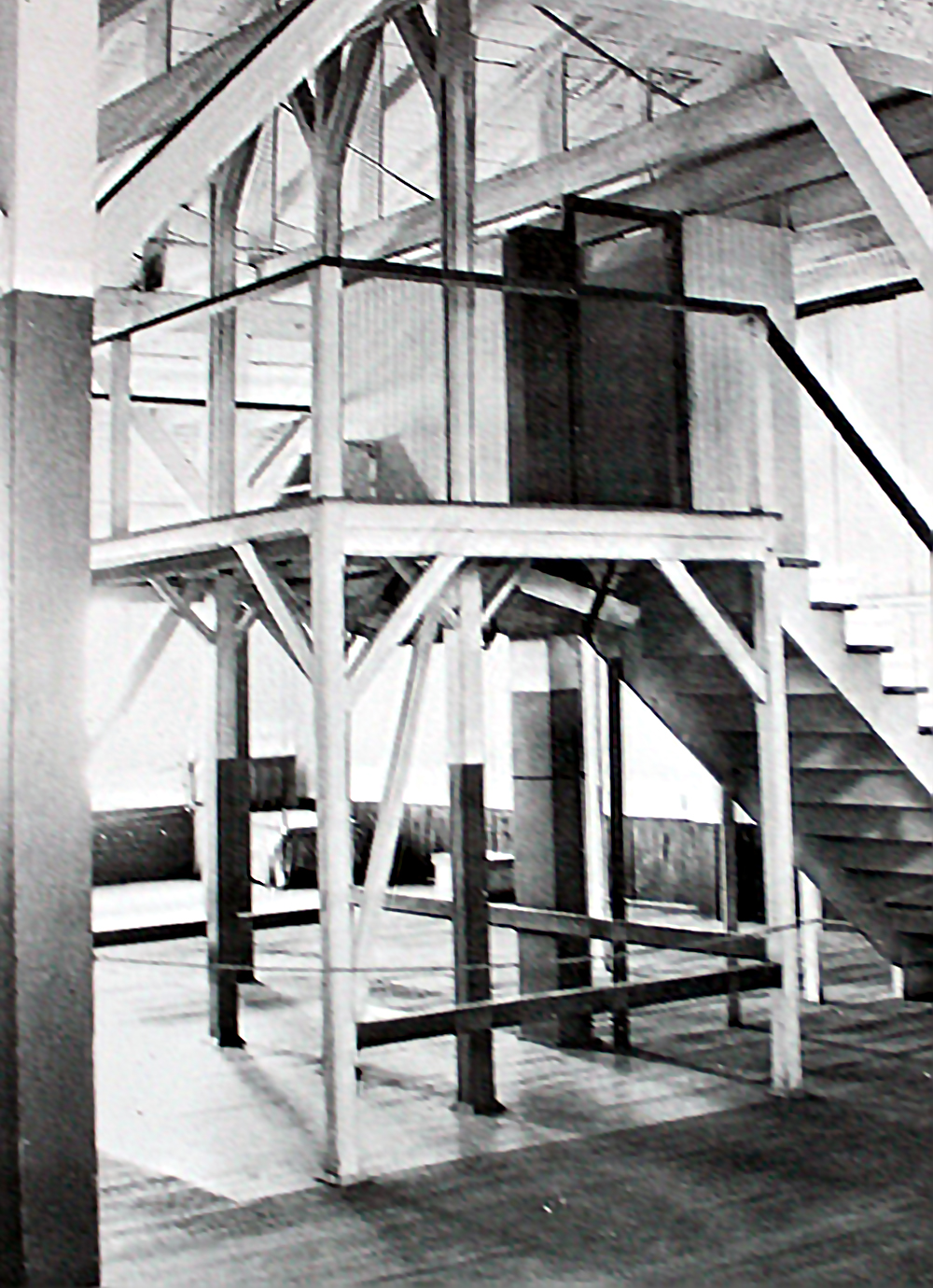
San Quentin Prison's death penalty hanging gallows in the 1930s.
When California became a state in 1850, the sheriffs in each county were tasked with executing prisoners sentenced to death by the courts in their respective counties. State law only directed that executions should take place “within the walls or yard of a jail, or some private place in the country”.
After the serious crowd control problems that erupted during the 1854 execution of William Sheppard, for the next twenty-six years all San Francisco hangings were conducted inside the Broadway Jail or in the jail’s secured outside yard.
In 1890, the newly created California State Detention Bureau became responsible to conduct all statewide legal executions at either San Quentin Prison or Folsom Prison. On March 3, 1893, convicted San Diego murderer Jose Gabriel became the first person hanged at San Quentin Prison under the new law.
In 1938 the method of execution was changed from hanging by a rope to inhaling the fumes caused when cyanide pellets are dropped into a container of sulphuric acid (i.e., the gas chamber). And that year San Quentin’s newly installed death penalty gas chamber became the State’s sole execution location.
From 1893 to 1937, there were 215 executions by hanging at San Quentin and 92 at Folsom Prison. From 1938 to 1993, there were 196 gas chamber executions at San Quentin (four of them women), and from 1996 to 2006 there were 10 executions by lethal injection. In 2019 Governor Gavin Newsom signed an executive moratorium on all State executions and the San Quentin gas chamber was dismantled.
The State Detention Bureau was renamed the California Department of Corrections in 1951, then renamed again as the California Department of Corrections and Rehabilitation in 2004.
Sheppard then took off his coat. He shook hands again with the Sheriff and several others. His arms and feet were bound and a white cap was placed over his head. At 1:31 pm, the bolt was drawn by Sheriff Gorham and Sheppard dropped into the open air. “The muscular contractions of the lower limbs continued for four or five minutes, but his death appeared to be a comparatively easy one. Throughout the whole of arrangements, he appeared utterly indifferent and met his fate with a firmness that we scarcely supposed human nature was capable of.” After hanging for about twenty minutes, his body was cut down and turned over to the coroner.
After the execution, The Alta newspaper proclaimed its disgust with the spectacle, noting that “some vile wretch” had obtained a portion of the hangman’s rope and was selling it in half inch pieces for twenty-five cents per piece. “Such acts as these are base slurs on poor human nature.” They also reported the existence of drunken spectators.
“Gallows Birds. Six wretches, specimens of dilapidated humanity, soon after the execution, were discovered in a beastly state of intoxication close to the foot of the gallows. Their nervous temperament was probably of so delicate an order that they found it necessary to fortify the inner man with an undue quantity of execrable whiskey, in order to endure with fortitude the painful scene they had come to witness.” (Alta, 7-3-1854.)
The Alta was more than disgusted with the public conduct at the hanging. While not taking a firm stance for or against the death penalty, the paper was clear in urging that executions should not become public spectacles.
“It is sincerely hoped that the execution which took place yesterday is the last public execution that will ever be permitted in this country. The thousands who to gratify a morbid curiosity, rode and walked through the sun and dust four miles to see a fellow creature’s body dangling in the air, have been this time satisfied... Familiarity with such scenes only rob them of their terror, and we believe that every person who witnessed the execution yesterday is more likely to become a murderer than he was before.” (Alta, 7-29-1854.)
In fact, this was the last lawful public execution in San Francisco. (The 1856 Committee of Vigilance conducted four illegal hangings seen by small numbers of the public.) Hereafter, all court ordered hangings took place in the Broadway Jail. Executions continued to draw large and unruly crowds in the street outside the jail, but only those with a ticket or invitation from the Sheriff were allowed inside the jail to observe the execution. Sheriff Gorham never again conducted an execution and did not seek reelection a year later in 1855.
Sheriff William Gorham
William Gorham was the first San Francisco sheriff elected from the local Democratic Party, winning the office on election day September 7, 1853.
A look at the Sheriff’s staff in 1854 shows that his deputy sheriffs included Gorham’s successor in 1855, David Scannell, and a future candidate, John Harrison, who ran unsuccessfully in 1857 against Sheriff Charles Doane.
Gorham and Scannell were commanders of The San Francisco Blues, one of the many local military (or militia) units that populated San Francisco during its early days. William Gorham was the first leader of The San Francisco Blues, commissioned as Captain in November 1852. Commissioned at the same time was his First Lieutenant, David Scannell. Gorham served as Captain of The Blues for at least part of the same time he was the elected Sheriff. (The California State Military Museum.)
State militia units were the precursor to today’s National Guard of California. “In 1849, the California Constitution created California’s militia force, creating a supplemental or reserve force to the functions of the United States military.”
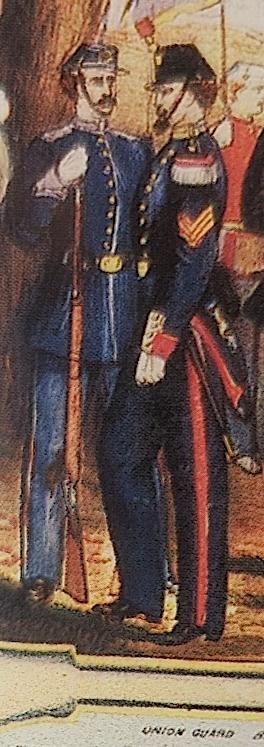
William Gorham was a Captain in San Francisco's Union Guard militia from 1861-1863. Here is an image of the unit's uniform.
In 1850, the California legislature enacted a Military Law, which authorized militia units under an Adjutant General, with the Governor as commander in chief. The California law was patterned after the federal Militia Act of 1792 which declared “that all free white men between the ages of eighteen and forty-five, except those who had already served a full term in the army or navy, or were members of volunteer companies within the state, were subject to enrollment for military duty in the state.”
Many of the most dynamic leaders of San Francisco’s early days were members of one of the major militia units in the City. Four of the first five sheriffs were militia members (Gorham, Scannell, Doane, Ellis), often serving as militia officers while still in elected office. Gorham also served as the Captain of the Union Guard unit in 1861 through at least 1863.
After leaving office in 1855, William Gorham served as a Brigadier General in the California Militia. In the Annual Report to Governor John Bigler, dated December 15, 1855, Quarter Master William Kibbe lists William Gorham as the Brigadier General of the Second Brigade, Second Division and also lists among the officers of the First California Guard, Orderly Sergeant John S. Ellis, who became Sheriff of San Francisco in 1861. (Charles Doane was also appointed to the post of Brigadier General in 1861).
William Gorham’s road to the office of sheriff was controversial. Sheriff Jack Hays had resigned toward the end of his second term and one of his popular deputy sheriffs, Thomas Johnson, was appointed by the Board of Supervisors to finish out Hays’ term.
Sheriff Johnson launched his campaign for reelection and received endorsements from several prominent nonpartisan organizations. Other candidates sought the office as well: The very popular Chief Engineer of the Fire Department (the equivalent of today’s Fire Chief), George Hossefross, a person named Nathaniel Blackstone who listed himself in newspaper ads as “Democratic candidate for Sheriff”, and Democratic candidate William R. Gorham. George Hossefross became the candidate of the other major party, The Whigs. Hossefross came to San Francisco in 1849, was a member of the Executive Committee of the 1851 Vigilance Committee and was also involved with the 1856 Committee of Vigilance.
Gorham became the official candidate of the Democratic Party at the Party’s three-day Convention in August 1853. Included among the officers of the Democratic Party convention were future sheriffs David Scannell and William McKibben, as well as other prominent San Franciscans such as Sam Brannan and future victim of the Committee of Vigilance, James Casey. Gorham himself does not appear among the long list of official signers of the 1851 Committee of Vigilance roster.
When the office of Sheriff was up for nomination at the Democratic convention, it was reported that William Gorham was the only candidate. “A motion was made for nomination by acclamation. Cries of ‘No, no!’ Why should we ballot when there is only one candidate? ‘Ballot, ballot’. Mr. Laumeister said that he had been told by Mr. Johnson that he was not a candidate before the convention, and would in no case abide by the decision of the Convention.” (Alta, 8-28-53.)
Nevertheless, both Johnson’s and Gorham’s names were put before the convention with the final vote count being: Gorham 43, Johnson 21.
It was the opinion of The Alta that the efforts of the Democrats to elect office holders would be for naught. “The Democrats closed their convention on August 30th. As there is little hope for the success of their party in this city, not much importance is attached to their proceedings. They have been very disorderly.” (Alta, 9-1-1853.)
“There never was held in this city a political convention in which the personal character of the delegates generally was so questionable; and it is to be hoped that there never will be such another. If the great Democratic Party cannot find in its ranks better men than the majority of those who composed that Convention, then for Heaven’s sake let the Democratic Party go without nominees... The people of San Francisco are entirely too intelligent to respect the nominees of a dishonest convention, and the Democratic Party managers must respect the intelligence of the people, or they need not hope for success.” (Alta, 9-2-1853.)
Although a Democrat, incumbent Sheriff Johnson refused to seek the Party’s nomination. One of the conditions of an endorsement from the Party was that all candidates support everyone on the Democratic ticket. It also was reported that the nomination was basically for sale; that convention delegates “sold their votes to the highest bidder for more than one office.” (Alta, 9-2-1853.)
Johnson placed a paid advertisement in both daily newspapers that ran for several days prior to the election. In the ad he explained:
“I have declined being an applicant for a nomination at the hands of any political convention believing that if I have discharged my duties to the satisfaction of the public, that public would give me a free and unbiased support.
"In the Independent nomination tendered to me, I have a most ratifying proof that my efforts faithfully and energetically to discharge my duty have not been without their reward in the appreciation of my fellow citizens. Should I be elected, I can promise to bring to the performance of my official functions a zeal for the public service that shall know no abatement and that if I cannot comply with the behests of party, I shall at least execute the laws to the satisfaction of the people.” (Alta 9-2-1853.)
The Alta laid out its favorites and concerns in an editorial column of September 3, 1853. Of Chief Engineer Hossefross they said, “It is difficult to perceive how the qualities that fit him for the duties of Chief Engineer should be considered as a qualification for the office of Sheriff.” They were even more unimpressed with William Gorham: “In his vocation, Mr. Gorham is no doubt a respectable gentleman and good citizen; but that fact does not impose upon the people of San Francisco county any obligation to confer upon an incompetent man so responsible an office as that of Sheriff.” Apart from his experience as a militia officer, William Gorham’s profession, indeed, does not suggest a background for law enforcement. His profession on several endorsement advertisements is listed as “Baker.”
Their choice was the incumbent. “Mr. Johnson, the present incumbent, who is, we believe, acknowledged by men of all parties to be thoroughly qualified by natural endowments, energy of character, and by long practical familiarity with the complicated details of the office, having refused to submit his name to the action of the Democratic caucus, is running as an independent candidate, and will doubtless receive a heavy vote.”
The other major San Francisco newspaper also supported Johnson: “We shall regard the Independent Ticket defeated unless Mr. Johnson be elected Sheriff. Need we say how much depends on his success and how every good citizen should work to elect him? He is the worthy successor of Col. Jack Hays, and is one of the few men who redeem the official character of this City. Let him not be defeated. (San Francisco Daily Herald, 9-7-1853.)
California State law limited voters to “every white male citizen of the United States and every white male citizen of Mexico who shall have elected to become a citizen of the United States under the treaty of peace.” A voter had to be 21 years of age. “No idiot or insane person” could vote, nor could a person who had been convicted of an “infamous crime,” which was any crime punishable by death or imprisonment in the state prison. (Alta, 9-7-53.)
When the final votes were counted, the emerging power of party politics was evident. Sheriff Tom Johnson had lost to William Gorham and only barely beat George Hossefross, with Gorham the overwhelming winner. (Gorham: 4,942; Johnson: 3,073; Hossefross: 2,857). The fourth candidate, Nathaniel Blackstone, received only 24 votes. (Alta, 10-1-53.)
The Fire Chief did not take his defeat well. As soon as the results were in, George Hossefross resigned as Chief Engineer, a position he had held by election for several years. The Alta noted, “His resignation is a source of regret to the Department and to the whole community.” (Alta, 9-14-53.)
Sheriff Gorham took little time in addressing the problems in the county jail. The minutes of the Board of Supervisors of October 26th, contains the following report:
“The Committee on Public Buildings, to whom had been referred the communication of Sheriff Gorham relative to the county jail, reported that the jail was too small, ventilation impossible, and the atmosphere unhealthy and offensive. One cell, fourteen by sixteen feet, contained 17 prisoners; another cell, twelve by fourteen feet, contained 10 prisoners; the other cells, seven by nine feet, contained each five prisoners. The Committee recommended the construction of another row of cells, according to the original plan of the building, which would probably give capacity enough to accommodate the prisoners for two years to come. The probable cost would be about $20,000. They also recommended that a new roof, covered with zinc, be erected. The present roof was very bad, and would afford but little protection to the inmates during the rainy season.
“An order accompanied the Report that the Committee on Public Buildings advertise the proposal to erect a new roof on the county jail, and to award the contract. Order passed.
“An order that the Committee on Public Buildings advertise ten days for proposals to build another row of cells to the county jail and shall award the contract. Order passed.” (Alta, 10-27-1853.)
The very next month, Sheriff Gorham found himself in another controversy: whether county jail prisoners should be used to perform street cleaning duties. The Alta was adamant this move forward. “Our streets are now reeking with filth, and the stews of the Five Points on their palmist days never sent up more horrible perfumes than do some of our most public thoroughfares.”
As to the prisoners, The Alta noted that one only has to visit the Court to see, “a large number of drunken loafers, notorious vagrants, and petty thieves.” Nothing came of this outrage as the Board of Commons took no action.
As Sheriff, Gorham remained active with the San Francisco Blues militia unit. In January 1854, Captain Gorham led the Blues on a public march to the wharf, where they boarded The Senator” for a voyage up to San Pablo Bay and the State Capitol in Benicia, to attend the Governor’s inauguration. They were back in San Francisco by 7:00 pm that evening.
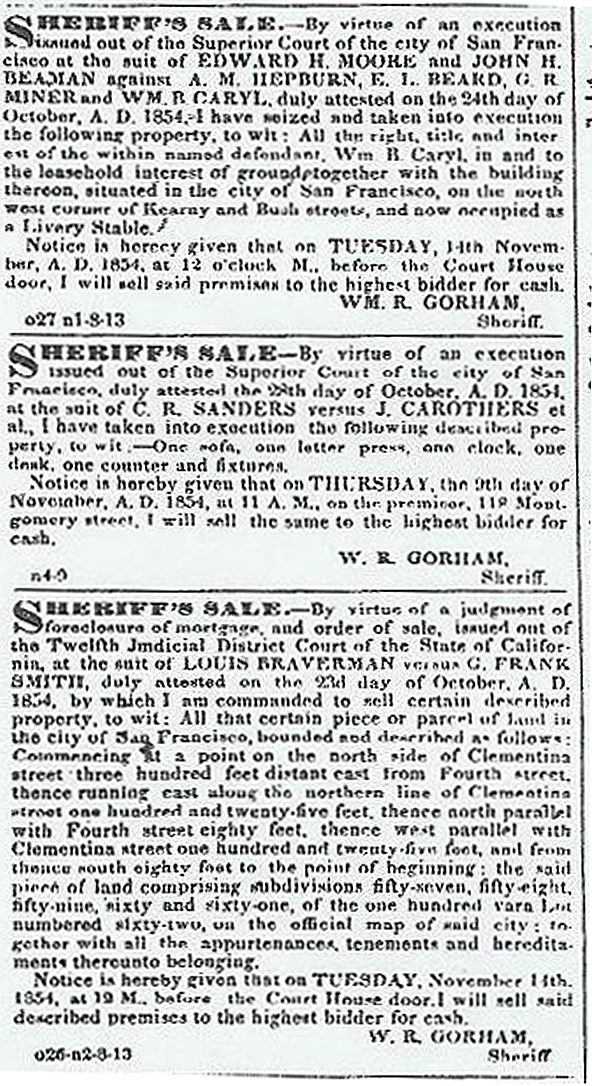
Various civil sale notices of seized property posted by Sheriff William Gorham in The Alta newspaper.
In February of 1854 the local Grand Jury filed its a report addressing on a number of vexing civic issues. Foremost among them was the “many cases of public brawls and private quarrels that have occurred late at night, when the parties engaged therein were under a state of excitement, produced by the effects of the use of intoxicating liquors.”
The Grand Jury also inspected various County institutions, including the County Jail. Regarding the jail, their comments were brief: “Considering the crowded state of the County Prison, the Jury believe that all proper attention is given by Sheriff Gorham and Mr. Keeper Barnard, to the safety and health of the unfortunate inmates. In a few weeks the additional building will be completed, and the Sheriff will be able to separate and classify the prisoners with more regard to ventilation and cleanliness.” (Alta, 2-5-1854.)
The Jury was also concerned that the death penalty was being undermined by improperly influenced jurors. They urged that the selection of jurors be “made by the High Sheriff himself, from that class of citizens who can neither be bought up nor intimidated.” It should be noted that the Secretary of the Grand Jury was Isaac Bluxome, a man who was the Secretary and voice of the Committee of Vigilance in both 1851 and 1856. The hanging of criminals was a high priority with many in San Francisco.
The Grand Jury filed another report regarding the county jails only two months later, this time in greater depth. “This Jury have twice visited the County Jail, and are please to speak in the highest terms of approbation of the clean and health condition of the interior management.” (Alta 4-2-1854.)
The addition of the new cells was underway and the Jury recommended the purchase of adjoining land to allow for further expansion. “The prisoners could be set to work to excavate the rock and dirt upon the land proposed.” As the Broadway Jail was set back against rocky and dense Telegraph Hill, getting that work completed would be quite a task. The jury also recommended that an “Alms House” be established for paupers who “are sufficiently free from all diseases not to require hospital care.” They could be required to work at gardening or to otherwise defray the expenses of the institution. Decades later this idea took hold in the form of The House of Refuge, near the site of today’s City College. In spite of these good intentions, the House of Refuge eventually became another jail facility.
In the 1850s, crime in San Francisco was a booming business. In May 1854 the Court Clerk noted 393 cases, including 6 murders, 1 arson, 107 drunk and disorderly, 71 assault and battery, 51 petit larceny, 26 grand larceny, 19 riotous conduct, 15 assault with deadly weapons, 2 embezzlements and a variety of misdemeanors and violations of local ordinances. By mid-July of 1854, the jail hit its highest number of prisoners yet: 106. (Alta 6-3-1854, 7-23-1854.)
The economy of San Francisco was not healthy during the last part of Gorham’s term and Sheriff’s Sales of seized property were regularly advertised in the local press, sometimes taking whole columns of notices.
William Gorham did not seek reelection to a second term, choosing instead to back his longtime friend and fellow leader of The Blues, David Scannell. Sheriff Scannell assumed office at a most challenging time, facing the lynching of jail prisoners by the Committee of Vigilance and a vote by the county Board of Supervisors to remove him from office. Considering the tumultuous term of Sheriff Scannell, Gorham’s decision not to run was probably a wise one.
Additional references: California Department of Corrections and Rehabilitation, Los Angeles Times, The Presidio San Francisco, California State Library
.jpg)
